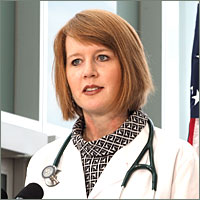Substance Use Disorder
News
A Computer Tool to Address Epidemic of Opioid Overdose Deaths
PA Governor Tom Wolf Urges Medical Professionals to Sign Up

Pennsylvania Governor Tom Wolf speaks at a University of Pennsylvania press conference where he announced the launch of a new state prescription drug monitoring system designed to tighten access to prescription opioid drugs and other controlled substances.
Pennsylvania Governor Tom Wolf on Thursday announced the launch of a new Prescription Drug Monitoring Program (PDMP) designed to log and analyze every prescription for opioids and other controlled substances dispensed anywhere in the state.
The new web-based computer program is Pennsylvania’s latest tool in the battle to lower the body count of prescription drug overdose deaths that has become the state’s most pressing health challenge.
Wolf made the announcement at a press conference in the University of Pennsylvania’s Perelman School of Medicine where he was accompanied by Secretary of Health Karen Murphy, RN, PhD, and Deputy Secretary for Health Innovation at the Pennsylvania Department of Health Lauren Hughes, MD, MPH.

All three emphasized the severity of the state’s prescription opioid overdose crisis, noting that 3,500 Pennsylvanians are dying annually and that number continues to rise. Hughes, who oversees the new PDMP program called the situation “the worst public health crisis Pennsylvania has experienced in recent history.”
‘Doctor shopping’
A Prescription Drug Monitoring Program (PDMP) is a statewide database into which pharmacists and clinicians who dispense drugs are required to record the individual sales of controlled substances. The system can automatically monitor and analyze the incoming data to identify patients who are involved in “doctor shopping” — practice of simultaneously receiving opioid prescriptions from different doctors.
The Pennsylvania PDMP law requires pharmacists to enter dispensing data into the PDMP system within 72 hours after the patient gets the prescription. The stored data for each prescription includes the prescribing doctor, patient and drug’s name, dosage, date, pharmacy and payment method.
The PDMP data can also be used in a variety of other ways to more effectively support drug abuse-related education, research and enforcement efforts. Pennsylvania’s PDMP office is currently most focused on encouraging physicians to routinely query the system before prescribing an opioid medication for a patient.
A new website has been launched by the Health Department to support PDMP registration and technical support for the state’s physicians and pharmacists.
“As a practicing Pennsylvania physician, I can tell you that my colleagues and I have been eagerly awaiting a usable PDMP,” said Penn emergency physician Zachary Meisel. “We know that states that implemended PDMPs have seen immediate and sustainable reductions in opioid prescribing.”
CHERISH research program
Meisel, a health services researcher and Senior Fellow at the Leonard Davis Institute of Health Economics (LDI), is also a member of the research team at the Center for Health Economics of Treatment Interventions for Substance Use Disorder, HCV, and HIV (CHERISH). That collaborative project of Weill Cornell Medicine, Boston Medical Center, LDI and the University of Florida is heavily involved in opioid addiction research.
Meisel is also the co-author of a recent study of PDMP use by emergency room physicians that details the successes and unresolved issues of such systems.
“A usable PDMP should help Pennsylvania doctors not only make better decisions to limit opioid prescriptions for patients who are getting too much,” Meisel said, “but it can also help patients with pain get appropriate treatment.”
‘Key first step’
However, Meisel also noted that PDMP availability alone isn’t an instant solution. “Physicians will have to be able to find it easy to use and integrate it into their daily practice but having this new working system is a key first step.”
In June, a team led by CHERISH researchers Yuhau Bao and Bruce Schackman, both of Weill Cornell Medical College, published the findings of a study of the results achieved in 24 states that operated PDMPs from 2001 to 2010.
That Health Affairs article reported that “the implementation of a prescription drug monitoring program was associated with more than a 30 percent reduction in the rate of prescribing of Schedule II opioids. This reduction was seen immediately following the launch of the program and was maintained in the second and third years afterward.”